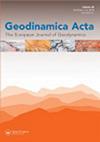豫西南西夏盆地上白垩统遗迹化石与沉积环境
IF 1.5
Q1 Earth and Planetary Sciences
引用次数: 9
摘要
西夏盆地上白垩统高沟组、马家春组、四沟组为陆相碎屑沉积,以紫红色泥岩、泥质粉砂岩、粉砂岩、灰白色细粒砂岩为主,间或穿插灰白色、灰白色中、粗粒砂岩或砾岩。它们包含10个鱼属和22个鱼种和根石岩,包括砂粒石。古细菌;,南极信标,长角信标,冠状信标,圆柱。、西夏胃虫、特大古狐猴、管状斑狐猴、赫伯特斑狐猴、沟状斑狐猴、沟状斑狐猴、纹状斑狐猴、贝莱斑狐猴。、细穗草、垂穗草、线穗草、细穗草。,不规则带绦虫,蛇形绦虫和巴雷蒂绦虫。根据沉积特征,从北向南可识别出冲积扇、辫状河、曲流河和河湖体系。在此基础上,划分出辫状河和曲流河河道环境下的Skolithos-Gastruichnus鱼群组合,天然堤岸和裂口发育的Beaconites-Taenidium鱼群组合,冲积平原发育的Beaconites-Palaeophycus鱼群组合,周期性暴露的河湖(塘或极浅湖)沉积环境下的taenidius - scoyenia鱼群组合。本研究不仅丰富了陆源遗迹化石数据库,而且为进一步完善陆相模式提供了新的数据,也为西夏盆地古环境提供了约束条件。本文章由计算机程序翻译,如有差异,请以英文原文为准。
Trace fossils and sedimentary environments of the upper cretaceous in the Xixia Basin, Southwestern Henan Province, China
The Upper Cretaceous Gaogou, Majiachun and Sigou formations in the Xixia Basin are composed of terrestrial clastic deposits, which are dominated by red-violet mudstones, muddy siltstones, siltstones, grayish fine-grained sandstones, intercalated with grayish, off-white medium- and coarse-grained sandstones or conglomerates. They contain 10 ichnogenera and 22 ichnospecies and Rhizoliths, including Arenicolites isp., Archaeonassa isp., Beaconites antarcticus, B. capronus, B. coronus, Cylindricum isp., Gastruichnus xixiaensis, Palaeophycus megas, P. tubularis, P. heberti, P. sulcatus, P. cf. sulcatus, P. striatus, Planolites beverleyensis, P. isp., Scoyenia gracilis, Skolithos verticalis, S. linearis, S. isp., Taenidium irregularis, T. serpentinum and T. barretti. From north to south across the basin, alluvial fan, braided and meandering fluvial and fluvio-lacustrine systems are recognised on the basis of sedimentary features. In reference to them, four ichnoassemblages are recognised: (1) Skolithos-Gastruichnus ichnoassemblage in the channel environment of braided and meandering river, (2) Beaconites-Taenidium ichnoassemblage in the natural levee and crevasse splays, (3) Beaconites-Palaeophycus ichnoassemblage in the flood plain and (4) Taenidium-Scoyenia ichnoassemblage in the periodically exposed fluvio-lacustrine (pond or very shallow lacustrine) sedimentary environments. The present work not only enrich the trace fossils database of terrestrial origin but also offer new data to complete further continental ichnofacies mode and also provide the constraints on palaeoenvironments of the Xixia Basin.
求助全文
通过发布文献求助,成功后即可免费获取论文全文。
去求助
来源期刊

Geodinamica Acta
地学-地球科学综合
CiteScore
4.50
自引率
0.00%
发文量
0
审稿时长
25 weeks
期刊介绍:
Geodinamica Acta provides an international and interdisciplinary forum for the publication of results of recent research dealing with both internal and external geodynamics. Its aims to promote discussion between the various disciplines that work on the dynamics of the lithosphere and hydrosphere. There are no constraints over themes, provided the main thrust of the paper relates to Earth''s internal and external geodynamics. The Journal encourages the submission of papers in all fields of earth sciences, such as biostratigraphy, geochemistry, geochronology and thermochronology, geohazards and their societal impacts, geomorphology, geophysics, glaciology, igneous and metamorphic petrology, magmatism, marine geology, metamorphism, mineral-deposits and energy resources, mineralogy, orogeny, palaeoclimatology, palaeoecology, paleoceanograpgy, palaeontology, petroleum geology, sedimentology, seismology and earthquakes, stratigraphy, structural geology, surface processes, tectonics (neoteoctonic, plate tectonics, seismo-tectonics, Active tectonics) and volcanism.
Geodinamica Acta publishes high quality, peer-reviewed original and timely scientific papers, comprehensive review articles on hot topics of current interest, rapid communications relating to a significant advance in the earth sciences with broad interest, and discussions of papers that have already appeared in recent issues of the journal. Book reviews are also included. Submitted papers must have international appeal and regional implications; they should present work that would be of interest to many different specialists. Geographic coverage is global and work on any part of the world is considered. The Journal also publishes thematic sets of papers on topical aspects of earth sciences or special issues of selected papers from conferences.
 求助内容:
求助内容: 应助结果提醒方式:
应助结果提醒方式:


